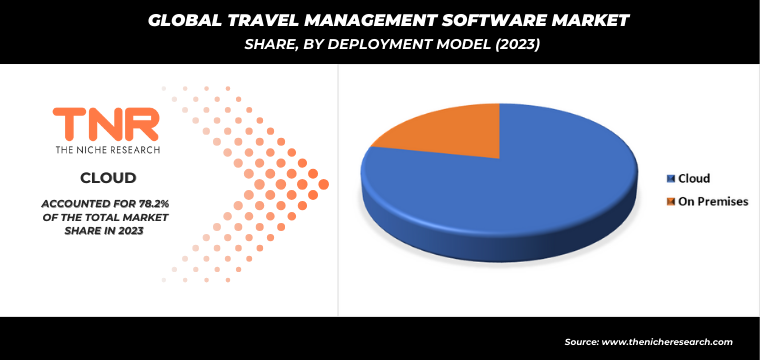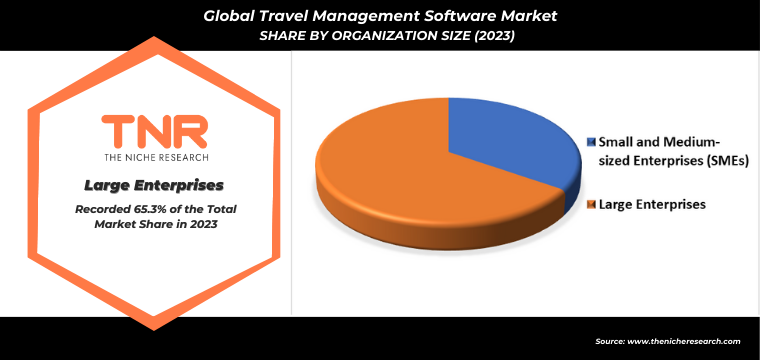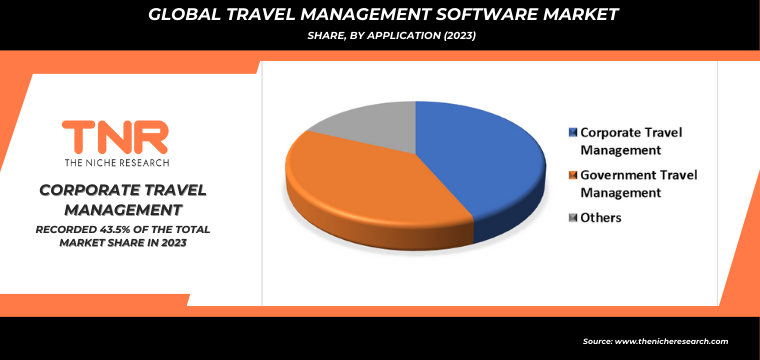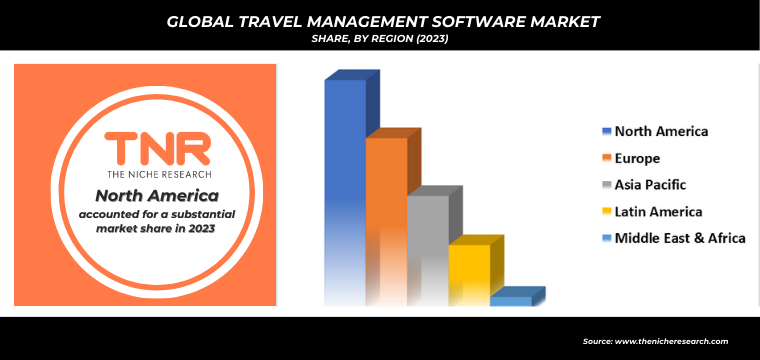Global Travel Management Software Market, By Deployment Model, By Organization Size, By Application, By Region & Segmental Insights Trends and Forecast, 2024 – 2034
- Industry: Technology
- Report ID: TNR-110-1212
- Number of Pages: 420
- Table/Charts : Yes
- July, 2024
- Base Year : 2024
- No. of Companies : 10+
- No. of Countries : 29
- Views : 10097
- Covid Impact Covered: Yes
- War Impact Covered: Yes
- Formats : PDF, Excel, PPT
In Terms of Revenue, the Global Travel Management Software Market was Worth US$ 4.1 Bn in 2023 and is Anticipated to Witness a CAGR of 9.6% During 2024 – 2034.
Travel Management Software (TMS) streamlines corporate travel planning and expense management. These solutions integrate travel booking, policy compliance, expense reporting, and analytics to enhance efficiency and cost-effectiveness. TMS allows organizations to manage travel plans, approvals, and budgets from a single platform, improving control over travel-related expenses and ensuring policy adherence. By automating processes and providing real-time data, TMS helps businesses optimize their travel operations, reduce costs, and enhance traveler satisfaction.
The travel management software market is experiencing significant growth, driven by the increasing demand for efficient corporate travel solutions. The market is projected to expand due to the rising need for businesses to streamline travel processes, manage expenses effectively, and ensure policy compliance. Key players in the market are continuously innovating to offer advanced features like AI-powered analytics, mobile accessibility, and seamless integration with other enterprise systems. This innovation is fueling market expansion and creating new opportunities for service providers.
The market is witnessing trends such as the adoption of AI and machine learning for predictive analytics, enhancing decision-making and personalized travel experiences. Mobile accessibility is becoming crucial as businesses seek to provide employees with on-the-go travel management solutions. There is also a growing demand for end-to-end solutions that integrate travel booking, expense management, and compliance tracking. Opportunities exist in expanding offerings to small and medium-sized enterprises (SMEs) and enhancing user experience through intuitive interfaces and robust customer support.
Key growth drivers include the increasing globalization of businesses, which necessitates efficient travel management solutions. The need for cost reduction and improved operational efficiency is pushing companies to adopt TMS. The rise of remote work and flexible working arrangements has increased the complexity of travel management, driving demand for sophisticated software solutions.

Travel Management Software Market Dynamic
Growth Driver-
Increasing Globalization Necessitates Efficient Travel Solutions to Manage Complex Itineraries and Cross-Border Travel
Companies are prioritizing cost reduction and operational efficiency, which TMS facilitates by automating travel planning and expense reporting. The rise of remote work and flexible arrangements has added complexity to travel management, increasing the demand for robust software solutions. Additionally, regulatory compliance requirements push organizations to adopt TMS for accurate tracking and reporting. Advancements in technology, including AI, machine learning, and blockchain, are enhancing the functionality and appeal of TMS, further fueling market growth. These factors collectively drive the adoption and expansion of travel management software.
Trends-
Adoption of AI and Machine Learning
The adoption of AI and machine learning is transforming the landscape by enabling predictive analytics, which enhances decision-making and personalizes travel experiences. Mobile accessibility is increasingly crucial, providing on-the-go travel management for business travelers. There is a shift towards end-to-end solutions that seamlessly integrate travel booking, expense management, and compliance tracking, offering a comprehensive approach to travel management. The market is witnessing increased focus on user experience, with intuitive interfaces and robust customer support becoming key differentiators. These trends highlight the market’s movement towards more intelligent, integrated, and user-friendly solutions, driving the evolution and growth of travel management software.
Challenge-
Data Security and Privacy
One major challenge is data security and privacy, as handling sensitive travel and personal information requires robust protection measures. Integrating TMS with existing enterprise systems can be complex and resource-intensive, posing a barrier for adoption. The rapid pace of technological advancements necessitates continuous updates and improvements, which can be costly and time-consuming for providers. User adoption is another hurdle, as businesses need to ensure that employees are adequately trained and willing to embrace new systems. Finally, varying regulatory requirements across regions complicate compliance efforts, requiring TMS solutions to be adaptable and customizable to meet diverse legal standards.
Travel Management Software Market Segmentation by Deployment Model, Organization Size, Application, Region
Cloud segment by deployment model is set to dominate the travel management software market, commanding a substantial revenue share of 78.2% over the forecast period. This dominance is driven by the advantages of cloud-based solutions, including scalability, flexibility, and cost-efficiency. Cloud TMS allows businesses to access real-time data, streamline travel processes, and enhance collaboration across global teams. It also facilitates seamless integration with other enterprise systems and offers robust security measures. The shift towards remote work and the need for mobile accessibility are further propelling the adoption of cloud-based TMS. The ability to update and maintain systems without significant IT infrastructure investments makes the cloud segment increasingly attractive for businesses of all sizes.

Large enterprises segment by organization size dominated the market and is anticipated to be the fastest-growing in the travel management software market, capturing a substantial revenue share of 65.3% over the forecast period. This growth is driven by the complex travel needs and higher budgets of large organizations, which necessitate sophisticated TMS solutions. Large enterprises benefit from comprehensive features such as detailed analytics, policy compliance, and seamless integration with existing systems. The demand for efficient travel management to reduce costs and enhance operational efficiency is particularly strong in this segment. Additionally, large enterprises prioritize robust security and scalability, further propelling the adoption of advanced TMS solutions tailored to meet their extensive requirements.

Corporate travel management segment by application dominated the travel management software market, accounting for a significant revenue share of 43.5%. This dominance is attributed to the growing need for businesses to streamline travel processes, control expenses, and ensure compliance with corporate policies. Corporate travel management solutions offer features such as automated booking, expense reporting, and real-time analytics, which help organizations manage their travel activities efficiently. The increasing globalization of businesses and the rise of remote work have further heightened the demand for robust travel management systems. By providing comprehensive tools to optimize travel arrangements and costs, the corporate travel management segment continues to be a critical driver of market growth.

In 2023, Latin America is anticipated to play a significant role in propelling the growth of the travel management software market, contributing approximately 11.1% to its overall expansion.
This growth is driven by increasing business travel activities in the region, fueled by economic development and the globalization of Latin American companies. The adoption of digital solutions is rising, as businesses seek to enhance travel management efficiency and control expenses. Additionally, the region’s growing tech-savvy workforce and improving internet infrastructure are facilitating the implementation of cloud-based TMS solutions. As companies in Latin America prioritize operational efficiency and compliance with travel policies, the demand for advanced travel management software is expected to continue its upward trajectory, contributing significantly to the market’s expansion.

Key Developments
- In January, 2024, TravelPerk, a business travel management platform, secured USD 104 million in a recent round of equity funding led by SoftBank’s Vision Fund 2. Other investors participating included Kinnevik and Felix Capital, resulting in a valuation of USD 1.4 billion, slightly higher than two years ago.
- In December, 2023, Expensify, Inc. announced a new partnership with Booking.com for Business, facilitated by Traxo. This collaboration enables business travelers to automatically import travel receipts from Booking.com for Business into Expensify during booking, simplifying expense management and reducing errors to improve overall customer satisfaction.
Major Players in Travel Management Software Market
- Abacus Labs Inc.
- Apptricity Corp
- Basware Corp.
- BCD Travel
- Chrome River Technologies Inc.
- Expensify Inc.
- Fingage
- Fraedom Holdings Limited
- Fyle Technologies
- Happay
- Infor Inc.
- Nexonia Inc.
- Paychex Inc.
- Rydoo
- TravelBank
- Xpenditure
- Zoho Corporation
- Other Industry Participants
Global Travel Management Software Market Scope
| Report Specifications | Details |
| Market Revenue in 2023 | US$ 4.1 Bn |
| Market Size Forecast by 2034 | US$ 11.2 Bn |
| Growth Rate (CAGR) | 9.6% |
| Historic Data | 2016 – 2022 |
| Base Year for Estimation | 2023 |
| Forecast Period | 2024 – 2034 |
| Report Inclusions | Market Size & Estimates, Market Dynamics, Competitive Scenario, Trends, Growth Factors, Market Determinants, Key Investment Segmentation, Product/Service/Solutions Benchmarking |
| Segments Covered | By Deployment Model, By Organization Size, By Application, By Region |
| Regions Covered | North America, Europe, Asia Pacific, Middle East & Africa, Latin America |
| Countries Covered | U.S., Canada, Mexico, Rest of North America, France, The UK, Spain, Germany, Italy, Nordic Countries (Denmark, Finland, Iceland, Sweden, Norway), Benelux Union (Belgium, The Netherlands, Luxembourg), Rest of Europe, China, Japan, India, New Zealand, Australia, South Korea, Southeast Asia (Indonesia, Thailand, Malaysia, Singapore, Rest of Southeast Asia), Rest of Asia Pacific, Saudi Arabia, UAE, Egypt, Kuwait, South Africa, Rest of Middle East & Africa, Brazil, Argentina, Rest of Latin America |
| Key Players | Abacus Labs Inc., Apptricity Corp, Basware Corp., BCD Travel, Chrome River Technologies Inc., Expensify Inc., Fingage, Fraedom Holdings Limited, Fyle Technologies, Happay, Infor Inc., Nexonia Inc., Paychex Inc., Rydoo, TravelBank, Xpenditure, Zoho Corporation |
| Customization Scope | Customization allows for the inclusion/modification of content pertaining to geographical regions, countries, and specific market segments. |
| Pricing & Procurement Options | Explore purchase options tailored to your specific research requirements |
| Contact Details | Consult With Our Expert
Japan (Toll-Free): +81 663-386-8111 South Korea (Toll-Free): +82-808- 703-126 Saudi Arabia (Toll-Free): +966 800-850-1643 United Kingdom: +44 753-710-5080 United States: +1 302-232-5106 E-mail: askanexpert@thenicheresearch.com
|
Global Travel Management Software Market
By Deployment Model
- Cloud
- On Premises
By Organization Size
- Small and Medium-sized Enterprises (SMEs)
- Large Enterprises
By Application
- Corporate Travel Management
- Government Travel Management
- Others
By Region
- North America (U.S., Canada, Mexico, Rest of North America)
- Europe (France, The UK, Spain, Germany, Italy, Nordic Countries (Denmark, Finland, Iceland, Sweden, Norway), Benelux Union (Belgium, The Netherlands, Luxembourg), Rest of Europe)
- Asia Pacific (China, Japan, India, New Zealand, Australia, South Korea, Southeast Asia (Indonesia, Thailand, Malaysia, Singapore, Rest of Southeast Asia), Rest of Asia Pacific)
- Middle East & Africa (Saudi Arabia, UAE, Egypt, Kuwait, South Africa, Rest of Middle East & Africa)
- Latin America (Brazil, Argentina, Rest of Latin America)
Report Layout:

Table of Contents
Note: This ToC is tentative and can be changed according to the research study conducted during the course of report completion.
**Exclusive for Multi-User and Enterprise User.
Global Travel Management Software Market
By Deployment Model
- Cloud
- On Premises
By Organization Size
- Small and Medium-sized Enterprises (SMEs)
- Large Enterprises
By Application
- Corporate Travel Management
- Government Travel Management
- Others
By Region
- North America (U.S., Canada, Mexico, Rest of North America)
- Europe (France, The UK, Spain, Germany, Italy, Nordic Countries (Denmark, Finland, Iceland, Sweden, Norway), Benelux Union (Belgium, The Netherlands, Luxembourg), Rest of Europe)
- Asia Pacific (China, Japan, India, New Zealand, Australia, South Korea, Southeast Asia (Indonesia, Thailand, Malaysia, Singapore, Rest of Southeast Asia), Rest of Asia Pacific)
- Middle East & Africa (Saudi Arabia, UAE, Egypt, Kuwait, South Africa, Rest of Middle East & Africa)
- Latin America (Brazil, Argentina, Rest of Latin America)
The Niche Research approach encompasses both primary and secondary research methods to provide comprehensive insights. While primary research is the cornerstone of our studies, we also incorporate secondary research sources such as company annual reports, premium industry databases, press releases, industry journals, and white papers.
Within our primary research, we actively engage with various industry stakeholders, conducting paid interviews and surveys. Our meticulous analysis extends to every market participant in major countries, allowing us to thoroughly examine their portfolios, calculate market shares, and segment revenues.
Our data collection primarily focuses on individual countries within our research scope, enabling us to estimate regional market sizes. Typically, we employ a bottom-up approach, meticulously tracking trends in different countries. We analyze growth drivers, constraints, technological innovations, and opportunities for each country, ultimately arriving at regional figures.Our process begins by examining the growth prospects of each country. Building upon these insights, we project growth and trends for the entire region. Finally, we utilize our proprietary model to refine estimations and forecasts.
Our data validation standards are integral to ensuring the reliability and accuracy of our research findings. Here’s a breakdown of our data validation processes and the stakeholders we engage with during our primary research:
- Supply Side Analysis: We initiate a supply side analysis by directly contacting market participants, through telephonic interviews and questionnaires containing both open-ended and close-ended questions. We gather information on their portfolios, segment revenues, developments, and growth strategies.
- Demand Side Analysis: To gain insights into adoption trends and consumer preferences, we reach out to target customers and users (non-vendors). This information forms a vital part of the qualitative analysis section of our reports, covering market dynamics, adoption trends, consumer behavior, spending patterns, and other related aspects.
- Consultant Insights: We tap into the expertise of our partner consultants from around the world to obtain their unique viewpoints and perspectives. Their insights contribute to a well-rounded understanding of the markets under investigation.
- In-House Validation: To ensure data accuracy and reliability, we conduct cross-validation of data points and information through our in-house team of consultants and utilize advanced data modeling tools for thorough verification.
The forecasts we provide are based on a comprehensive assessment of various factors, including:
- Market Trends and Past Performance (Last Five Years): We accurately analyze market trends and performance data from preceding five years to identify historical patterns and understand the market’s evolution.
- Historical Performance and Growth of Market Participants: We assess the historical performance and growth trajectories of key market participants. This analysis provides insights into the competitive landscape and individual company strategies.
- Market Determinants Impact Analysis (Next Eight Years): We conduct a rigorous analysis of the factors that are projected to influence the market over the next eight years. This includes assessing both internal and external determinants that can shape market dynamics.
- Drivers and Challenges for the Forecast Period:Identify the factors expected to drive market growth during the forecast period, as well as the challenges that the industry may face. This analysis aids in deriving an accurate growth rate projection.
- New Acquisitions, Collaborations, or Partnerships: We keep a close watch on any new acquisitions, collaborations, or partnerships within the industry. These developments can have a significant impact on market dynamics and competitiveness.
- Macro and Micro Factors Analysis:A thorough examination of both macro-level factors (e.g., economic trends, regulatory changes) and micro-level factors (e.g., technological advancements, consumer preferences) that may influence the market during the forecast period.
- End-User Sentiment Analysis: To understand the market from the end-user perspective, we conduct sentiment analysis. This involves assessing the sentiment, preferences, and feedback of the end-users, which can provide valuable insights into market trends.
- Perspective of Primary Participants: Insights gathered directly from primary research participants play a crucial role in shaping our forecasts. Their perspectives and experiences provide valuable qualitative data.
- Year-on-Year Growth Trend: We utilize a year-on-year growth trend based on historical market growth and expected future trends. This helps in formulating our growth projections, aligning them with the market’s historical performance.
Research process adopted by TNR involves multiple stages, including data collection, validation, quality checks, and presentation. It’s crucial that the data and information we provide add value to your existing market understanding and expertise. We have also established partnerships with business consulting, research, and survey organizations across regions and globally to collaborate on regional analysis and data validation, ensuring the highest level of accuracy and reliability in our reports.









